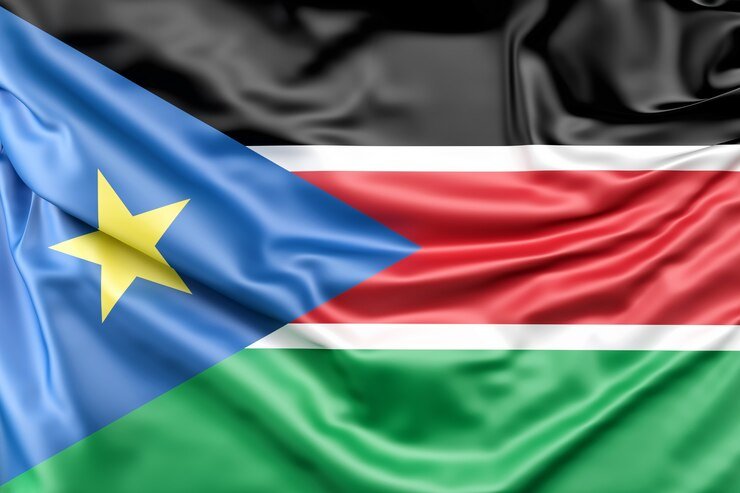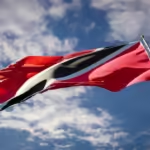The Southern Sudan flag stands as a symbol of freedom, unity, and hope for the people of South Sudan. The flag’s unique colors and design encapsulate the history, struggle, and aspirations of a newly independent nation that emerged after decades of conflict. In this article, we’ll delve into the significance of the Southern Sudan flag, exploring its history, meaning, and design elements, while comparing it to the flags of other nations and regions in Africa.
History of the Southern Sudan Flag
South Sudan, the world’s youngest country, officially gained independence from Sudan on July 9, 2011, following a referendum held in January of the same year. After decades of civil war, South Sudan’s independence marked the end of years of struggle, and the flag became a representation of this long-sought freedom.
Before independence, the region that would become South Sudan used various flags during the years of the Second Sudanese Civil War, which lasted from 1983 to 2005. During this period, the Southern Sudan People’s Liberation Army (SPLA) adopted a flag in 1991, which featured a similar color scheme to the current flag of South Sudan. After South Sudan achieved independence, this flag was officially retained and slightly modified, incorporating the essential elements of the SPLA flag but adapting it to reflect the new national identity.
The new Southern Sudan flag consists of horizontal stripes of green, white, red, and black, with a blue triangle containing a golden star, symbolizing the nation’s desire for unity, peace, and progress.
Elements of the Southern Sudan Flag
1. The Colors and Their Symbolism
Each color of the Southern Sudan flag carries deep symbolic meaning, reflecting the history, culture, and values of the South Sudanese people:
- Green: The green stripe at the bottom of the flag represents the country’s agricultural resources, land, and the hope for a prosperous future. It symbolizes the growth of a new nation and the importance of natural resources in South Sudan’s development.
- White: The white stripe, located between the red and green stripes, symbolizes peace and unity. It signifies the desire for a future free from conflict and division, emphasizing the hope for harmonious coexistence among South Sudan’s diverse ethnic groups.
- Red: The red stripe symbolizes the bloodshed and sacrifices made by the people of South Sudan during the struggle for independence. It stands as a tribute to the lives lost in the fight for freedom and represents the nation’s commitment to never forgetting their history.
- Black: The black stripe at the top of the flag represents the people of South Sudan, acknowledging the central role they play in the country’s identity. It emphasizes the importance of the South Sudanese people in building the nation’s future.
- Blue Triangle and Golden Star: The blue triangle is symbolic of the water resources in South Sudan, including the White Nile and Blue Nile rivers. These water sources are essential for life in the country and are a symbol of the country’s promise to overcome challenges. The golden star, located at the center of the triangle, represents the unity of the people and the country as a whole. It is a beacon of hope and a reminder of South Sudan’s aspiration to build a peaceful and prosperous future.
2. The Flag’s Design and Meaning
The Southern Sudan flag’s design mirrors the desires of the nation. The use of horizontal stripes emphasizes the country’s commitment to unity across different regions, ethnicities, and cultures. The central blue triangle cuts across the flag, acting as a reminder of South Sudan’s strategic location at the crossroads of Africa, bordered by some of the continent’s major rivers.
The golden star inside the blue triangle signifies the vision of South Sudan becoming a shining example of peace, progress, and development in Africa. Together, these elements represent a powerful call for stability, unity, and hope.
The Role of the Flag in South Sudanese Identity
The Southern Sudan flag is more than just a national symbol; it is a reflection of the struggles and aspirations of a people who have long yearned for independence. For South Sudanese citizens, the flag stands as a testament to their perseverance, resilience, and unity. It reminds them of their shared history, the sacrifices made during the long years of civil war, and the importance of working together for a brighter future.
The flag has become a symbol of pride for the people of South Sudan. During national celebrations, independence day festivities, and international events, the Southern Sudan flag is prominently displayed, symbolizing the unity of the people. It serves as a unifying force for citizens from different ethnic groups, fostering a sense of national pride and collective identity.
Comparison of the Southern Sudan Flag with Other African Flags
To appreciate the design of the Southern Sudan flag, it’s important to compare it with other flags from African nations. Many African countries use similar colors and motifs, often rooted in Pan-African symbolism. The chart below provides a brief comparison of the Southern Sudan flag with flags of other African nations:
| Country | Flag Design | Color Significance | Unique Features |
| South Sudan | Horizontal stripes of green, white, red, and black with a blue triangle containing a golden star | Green: Agriculture and prosperity, White: Peace and unity, Red: Sacrifice, Black: The people, Blue: Water resources, Golden star: Unity and hope | Unique blue triangle and golden star; represents both the geography and aspirations of the country |
| Kenya | Three horizontal stripes (black, white-edged red, green), with a red, white-edged shield and two crossed spears | Black: People of Kenya, Red: Struggle for independence, Green: Land, White: Peace | The shield and spears in the center are symbols of defense and protection |
| Ethiopia | Three horizontal stripes of green, yellow, and red with a blue circle and a star in the center | Green: Fertility, Yellow: Hope, Red: Sacrifice, Blue: Justice, Star: Unity | The circle and star in the middle of the flag symbolize unity and a strong national identity |
| Liberia | Red and white stripes with a blue square in the upper left corner containing a white star | Red: Courage, White: Purity, Blue: Liberty, Star: Freedom | The flag design was inspired by the American flag as Liberia was founded by freed American slaves |
| Uganda | Six horizontal stripes of black, yellow, and red with a gray crowned crane in the center | Black: The people of Uganda, Yellow: The wealth of the country, Red: The bloodshed in the struggle for independence | The crowned crane is the national bird and symbolizes freedom and pride |
The Flag’s Role in International Relations
Since South Sudan’s independence, the flag has been flown at international events and embassies worldwide, representing the country’s newfound status on the global stage. The Southern Sudan flag has also played an important role in fostering diplomatic relations with neighboring countries, as well as global powers and international organizations such as the United Nations. South Sudan’s flag is a constant reminder of the country’s long journey to independence and the ongoing challenges it faces in building a stable and prosperous future.
In South Sudan’s relations with neighboring Sudan, the flag is a point of tension and pride. The two nations share a turbulent history, but South Sudan’s flag has come to symbolize its sovereignty and desire to forge its own path as an independent country.
The Southern Sudan Flag in Cultural Context
In South Sudanese culture, the flag is widely recognized and celebrated. During festivals, national holidays, and public events, citizens proudly display the flag. It is used not only for governmental purposes but also in cultural ceremonies and performances that highlight South Sudan’s diversity.
The flag has found its way into South Sudanese art, music, and literature as well. It has inspired countless works by artists and writers who draw on the flag’s symbolism to express themes of unity, hope, and national pride. The flag is also a central motif in various forms of media that reflect the country’s national identity.
Challenges and Future of South Sudan’s Flag
While the Southern Sudan flag represents a hopeful future, South Sudan continues to face significant challenges, including political instability, internal conflict, and economic struggles. These issues, compounded by the nation’s underdeveloped infrastructure and limited resources, have hindered its progress since independence. However, the flag remains a beacon of hope, reminding the people of South Sudan of the sacrifices made to gain their freedom and the promise of a brighter future.
As South Sudan works to overcome its challenges, the flag will continue to symbolize the nation’s aspirations for peace, unity, and prosperity.
Conclusion
The Southern Sudan flag is a powerful symbol of the nation’s identity, unity, and hope for the future. Its design reflects the country’s struggles for independence, its rich cultural heritage, and its commitment to overcoming the challenges that lie ahead. With its vibrant colors and meaningful symbolism, the Southern Sudan flag will continue to inspire generations of South Sudanese citizens and stand as a beacon of hope for the rest of the world.
By understanding the history and meaning behind the flag, we gain a deeper appreciation for South Sudan’s journey toward independence and its ongoing quest for peace and progress. As the country continues to evolve, the Southern Sudan flag will remain an enduring symbol of resilience and aspiration.











